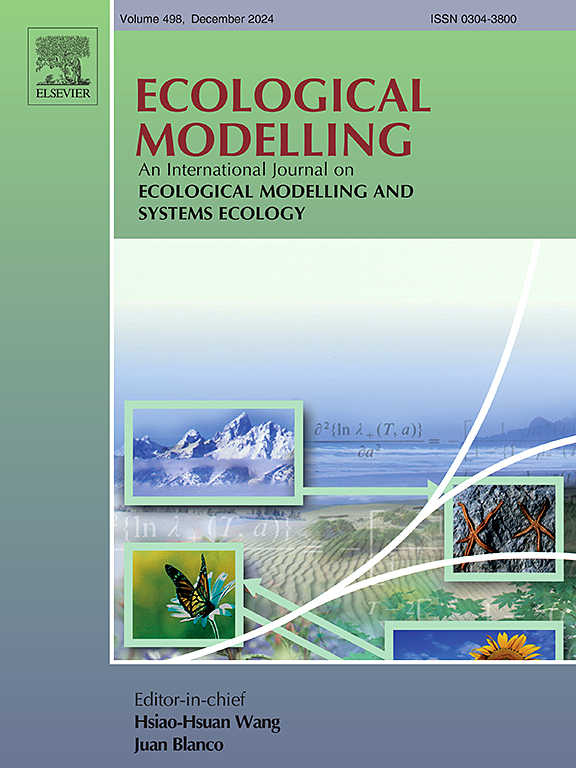多少才足够?优化蜂箱饲养密度,使依赖授粉者的作物产量最大化
IF 2.6
3区 环境科学与生态学
Q2 ECOLOGY
引用次数: 0
摘要
动物授粉对于保证依赖授粉作物的经济可行性至关重要,而蜜蜂(Apis mellifera L.)作为全球授粉服务管理中使用最多的物种,发挥着核心作用。尽管蜜蜂的重要性不言而喻,但有关蜜蜂蜂箱饲养密度的建议都是基于经验法则,即假定蜂箱为标准化单位,而不考虑作物花粉沉积需求的意外情况。我们开发了一个机械模拟模型,以评估不同蜂箱质量和饲养密度方案对蓝莓每公顷产量的影响。为此,我们使用贝叶斯模型、田间试验和二手信息对模拟进行参数化,并在作物层面估算探花率、花粉沉积量和果实产量。我们发现,每公顷 7 个优质蜂箱(20000 个蜂群-1)就能实现作物花粉沉积的最大化,而使用传统蜂箱(10000 个蜂群-1)则需要每公顷 20 个蜂箱才能达到类似的授粉水平。此外,要使蓝莓产量最大化(公顷-1),最佳的蜂箱饲养密度需要 4 个优质蜂箱(公顷-1),而 20 个传统蜂箱(公顷-1)就能达到类似的生产率水平。从经济和生产的角度来看,传统蜂箱较低的单位租赁价格可以补偿较少但较昂贵的优质蜂箱的使用。因此,在决定使用低质量蜂箱还是高质量蜂箱时,应考虑多使用 2.5 个蜂箱(每公顷)的后勤影响,以及使用卫生状况较差的蜂群对授粉服务稳定性的影响。我们的工作为蓝莓作物中蜜蜂蜂箱管理的生物和实证方案奠定了基础。事实上,结合蜜蜂和蓝莓授粉生态学,我们提供了一种务实的方法,根据蜂巢质量优化花粉沉积和作物产量(公顷-1)的最低蜂群密度,最大限度地提高作物产量。了解这样一个最小值可以降低农民的经营成本,降低授粉者对作物产量贡献的不确定性和不良授粉情况的风险,并有助于限制蜜蜂饱和生态系统可能带来的负面影响。本文章由计算机程序翻译,如有差异,请以英文原文为准。
How much is enough? Optimizing beehive stocking densities to maximize the production of a pollinator-dependent crop
Animal pollination is essential to guarantee the economic viability of pollination-dependent crops, and honeybees (Apis mellifera L.) play a central role as the most used species worldwide for pollination service management. Despite its importance, recommendations on honeybee hive stocking density are based on rules of thumb that assume hives as standardized units and do not consider the contingencies of the crop's pollen deposition demand. We developed a mechanistic simulation model to assess the consequences of variant hive quality and stocking density scenarios for blueberry productivity per hectare. To do so, we used Bayesian models, field experiments and secondary information to parametrize the simulation and estimate flower visitation rate, pollen deposition, and fruit production at the crop level. We found that maximizing pollen deposition at the crop level can be achieved with seven high quality-hives ha−1 (20000 bees colony−1), whereas reaching similar levels of pollination with conventional hives (10000 bees colony−1) would require 20 hives ha−1. Also, optimal hive stocking densities to maximize blueberry yield ha−1 needs four high quality-hives ha−1, whilst similar levels of productivity could be reached with 20 conventional colonies ha−1. From an economic and productive perspective, a lower unit rental price for conventional hives compensates for the use of less, but more expensive, high quality hives. Therefore, deciding using either low or high-quality hives should be based on, for instance, the logistic implications of using ∼2.5 more hives ha−1 and the consequences of using colonies with a poorer sanitation state for pollination service stability. Our work set the basis for a more biological and evidence-based protocol for honeybee hive management in blueberry crops. Indeed, integrating honeybee and blueberry pollination ecology, we provide a pragmatic approach to maximize crop productivity based on the minimum beehive stocking densities that optimize pollen deposition and crop yield ha−1 depending on hive's quality. Knowing such a minimum allows for reduced operation costs for farmers, lower uncertainty of pollinators contribution to crop productivity and the risk of undesirable pollination scenarios, and helps to limit the potential negative impacts of saturating ecosystems with honeybees.
求助全文
通过发布文献求助,成功后即可免费获取论文全文。
去求助
来源期刊

Ecological Modelling
环境科学-生态学
CiteScore
5.60
自引率
6.50%
发文量
259
审稿时长
69 days
期刊介绍:
The journal is concerned with the use of mathematical models and systems analysis for the description of ecological processes and for the sustainable management of resources. Human activity and well-being are dependent on and integrated with the functioning of ecosystems and the services they provide. We aim to understand these basic ecosystem functions using mathematical and conceptual modelling, systems analysis, thermodynamics, computer simulations, and ecological theory. This leads to a preference for process-based models embedded in theory with explicit causative agents as opposed to strictly statistical or correlative descriptions. These modelling methods can be applied to a wide spectrum of issues ranging from basic ecology to human ecology to socio-ecological systems. The journal welcomes research articles, short communications, review articles, letters to the editor, book reviews, and other communications. The journal also supports the activities of the [International Society of Ecological Modelling (ISEM)](http://www.isemna.org/).
 求助内容:
求助内容: 应助结果提醒方式:
应助结果提醒方式:


